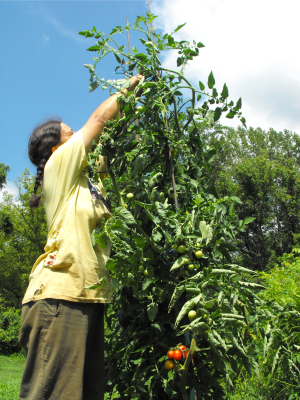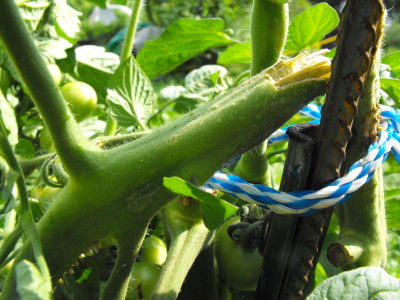
Pruning tomatoes for blight prevention
 Last
year, the blight took me by surprise and sent me reeling. Since
then, I've done a lot of plotting and researching, and I feel like I
have the possibility of harvesting a crop after the fungus hits.
Last
year, the blight took me by surprise and sent me reeling. Since
then, I've done a lot of plotting and researching, and I feel like I
have the possibility of harvesting a crop after the fungus hits.
I've talked about our
extreme tomato pruning
before, but I want to add a few notes since I can already tell that I'll be pruning slightly
differently next year. Most importantly, I plan to snip off the
bottom leaves repeatedly rather than spending my weekly pruning
sessions solely cutting back suckers and tying up the main stems.
I've noticed that even leaves attached a foot above the ground bend
downward with age until they are dipping into the splash zone.
Unsurprisingly, the first symptoms of the blight show up as yellowing
and browning of these leaves --- a sign that fungal spores are being
exposed to the air. In the future, I'll clip off low leaves as
soon as they droop.

| This post is part of our Organic Tomato Blight Control lunchtime
series.
Read all of the entries: |
Want more in-depth information? Browse through our books.
Or explore more posts by date or by subject.
About us: Anna Hess and Mark Hamilton spent over a decade living self-sufficiently in the mountains of Virginia before moving north to start over from scratch in the foothills of Ohio. They've experimented with permaculture, no-till gardening, trailersteading, home-based microbusinesses and much more, writing about their adventures in both blogs and books.
Want to be notified when new comments are posted on this page? Click on the RSS button after you add a comment to subscribe to the comment feed, or simply check the box beside "email replies to me" while writing your comment.

Tomato cages work with determinate tomatoes, but we like indeterminate tomatoes (which is what most heirlooms are) --- they just get too heavy for tomato cages. I'd suspect they'd get too heavy for bamboo too, but I could be wrong.
This year, tying them onto metal fenceposts is working quite well for us. It's more work to prune, and probably cuts yield a bit, but does seem to be slowing the spread of blight. You might want to check out http://www.mastergardeners.org/picks/tomato_staking.html, which gaves some great information on pros and cons of various methods.
Since blight (at least phytophthora infestans) is vulnerable to copper, maybe putting some copper mesh upright around the bottom of the plant or suspended it horizonally an inch or so over the ground around the plant would be of use? The latter configuration would keep the lower leaves off the ground too.
And as opposed to spraying with copper compounds, it won't get into the soil.
We are using Bamboo and some 1x2s currently, but they don't last more than a season or two and are only about 6 feet tall so the top couple feet are falling over when the tomatoes develop. We're looking for something that will last longer.
We do have some left over chainlink fence top rail that might be option for us.
In the long run, I highly recommend changing over to metal posts. I suspect our investment will still be making our tomato life easier in a decade or two.
For this year, I'll bet you can slide rebar in beside your current arrangement, maybe tie it once or twice to the bamboo and 1x2s, and get away with another year or two. Although not strong enough to support a tomato plant on its own, rebar seems to do great as a height extender for the top part of the plant.